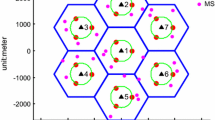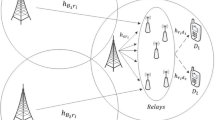Abstract
Wireless transmission systems are constrained by several parameters such as the available spectrum bandwidth, mobile battery energy, transmission channel impairments and users’ minimum quality-of-service. In this paper, a new strategy is investigated that aims at improving the allocation of resources in a dual hop OFDMA cooperative network consisting in multi source–destination pairs and multiple decode-and-forward relays. First, the joint optimization of three types of resources: power, sub-channel and relay nodes, is formulated as a problem of subchannel-relay assignment and power allocation, with the objective of minimizing overall transmission power under the bit-error-rate and data rate constraints. However, the optimal solution to the optimization problem is computationally complex to obtain and may be unfair. Assuming knowledge of the instantaneous channel gains for all links in the entire network, an iterative three-step resource allocation algorithm with low complexity is proposed. In order to guarantee the fairness of users, several fairness criteria are also proposed to provide attractive trade-offs between network performance (i.e. overall transmission power, average network lifetime and average outage probability) and fairness to all users. Numerical studies are conducted to evaluate the performance of the proposed algorithm in two practical scenarios. Simulation results show that the proposed allocation algorithm achieves an efficient trade-off between network performance and fairness among users.













Similar content being viewed by others
Notes
Margin adaptive.
Rate adaptive.
In this paper, the terms ‘source–destination pair’ and ‘user’ are often used interchangeably.
References
Marx, F., Farah, J., & Francis, C. (2005). Iterative correction of phase noise and non-linear distortion in orthogonal frequency division multiplexing (OFDM) systems. Annals of Telecommunications, 60(9–10), 1197–1218.
Marx, F., & Farah, J. (Sep. 2005). Iterative baseband correction of phase noise in OFDM systems for transmission over multi-path and AWGN channels. In Proceedings of the IEEE vehicular technology conference, USA.
Farah, J., & Marx, F. (2007). Combining strategies for the optimization of resource allocation in a wireless multiuser OFDM system. International Journal of Electronics and Communications (AEU), 61, 665–677.
Sendonaris, A., Erkip, E., & Aazhang, B. (2003). User cooperation diversity: Part I system description. IEEE Transactions on Communications, 51(11), 1927–1938.
Sendonaris, A., Erkip, E., & Aazhang, B. (2003). User cooperation diversity: Part II implementation aspects and performance analysis. IEEE Transactions on Communications, 51(11), 1939–1948.
Laneman, J. N., Tse, D. N. C., & Wornell, G. W. (2004). Cooperative diversity in wireless networks: Efficient protocols and outage behavior. IEEE Transactions on Information Theory, 50(12), 3062–3080.
Kramer, G., Gastpar, M., & Gupta, P. (2005). Cooperative strategies and capacity theorems for relay networks. IEEE Transactions on Information Theory, 51(9), 3037–3063.
Maham, B., Hjørungnes, A., & Debbah, M. (2009). Power allocations in minimum-energy SER constrained cooperative networks. Annals of Telecommunications, 64(7), 545–555.
IEEE802.16e. (2006) IEEE standard for local and metropolitan area networks part 16 and amendment 2. In IEEE.
Ekstrom, H., Furuskar, A., Karlsson, J., Meyer, M., Parkvall, S., Torsner, J., et al. (2006). Technical solutions for the 3G long-term evolution. IEEE Communications Magazine, 44, 38–45.
Dai, L., Gui, B., & Cimini, L. J., Jr. (2007). Selective relaying in OFDM multihop cooperative networks. In Proceeding of WCNC’07 (pp. 963–968), Hong Kong.
Gui, B., Dai, L., & Cimini, L. J., Jr. (2008) Selective relaying in cooperative OFDM systems: Two-hop random network. In Proceeding of WCNC’08 (pp. 996–100), Las Vegas.
Gui, B., & Cimini, L. J., Jr. (2008). Bit loading algorithms for cooperative OFDM systems. EURASIP Journal on Wireless Communications and Networking, 2008. http://www.hindawi.com/journals/wcn/2008/476797/. doi:10.1155/2008/476797.
IEEE802.16j (2006). IEEE standard for local and metropolitan area networks Part 16: Air interface for fixed and mobile broadband wireless access systems—multihop relay specification.
Kivanc, D., Guo-qing, L., & Hui, L. (2003). Computationally efficient bandwidth allocation and power control for OFDMA. IEEE Transactions on Wireless Communication, 2(6), 1150–1158.
Jang, J., & Lee, K. B. (2003). Transmit power adaptation for multiuser OFDM systems. IEEE Journal on Selected Areas in Communications, 21(2), 171–178.
Gui, B., Dai, L., & Cimini, L. J., Jr. (2006). OFDM for cooperative networking with limited channel state information. In Proceeding of Milcom, Washington, DC.
Hammerstrom, I., & Wittneben, A. (2006) On the optimal power allocation for nonregenerative OFDM relay links. In Proceeding of IEEE ICC’06, Vol. 10, pp. 4463–4468.
Hammerstrom, I., & Wittneben, A. (2006) Joint power allocation for nonregenerative MIMO-OFDM relay links. In Proceeding of IEEE ICASSP’06, Vol. 4, pp. 49–52.
Mu, H., Tao, M., Dang, W., & Xiao, Y. (2009) Joint subcarrier-relay assignment and power allocation for decode-and-forward multi-relay OFDM systems. In Proceeding of ChinaCom’09, pp. 26–28, Xi’an.
Dang, W., Tao, M., Mu, H., & Huang, J. (2010). Subcarrier-pair based resource allocation for cooperative multi-relay OFDM systems. IEEE Transactions on Wireless Communication, 9(5), 1640–1649.
Li, G., & Liu, H. (2006). Resource allocation for OFDMA relay networks with fairness constraints. IEEE Journal on Selected Areas in Communications, 24(11), 2061–2069.
Ng, T. C., & Yu, W. (2007). Joint optimization of relay strategies and resource allocations in a cooperative cellular network. IEEE Journal on Selected Areas in Communications, 25(2), 328–339.
Li, H., Luo, H., Wang, X., & Li, C. (2009) Throughput maximization for OFDMA cooperative relaying networks with fair subchannel allocation. In Proceeding of WCNC, pp. 1–6.
Han, Z., Himsoon, T., Siriwongpairat, W. P., & Liu, K. J. R. (2009). Resource allocation for multiuser cooperative OFDM networks: Who helps whom and how to cooperate. IEEE Transactions on Vehicular Technology, 58(5), 2378–2391.
Bletsas, A., Khisti, A., Reed, D. P., & Lippman, A. (2006). A simple cooperative diversity method based on network path selection. IEEE Journal on Selected Areas in Communications, 24(3), 659–672.
Papadogiannis, A., Saadani, A., & Hardouin, E. (2009). Exploiting dynamic relays with limited overhead in cellular systems. Paper presented at the Proceeding of GLOBECOM, Honolulu, HI.
Catreux, S., Driessen, P., & Greenstein, L. (2002). Data throughputs using multiple-input multiple-output (MIMO) techniques in a noise-limited cellular environment. IEEE Transactions on Wireless Communication, 1(2), 226–239.
Fischer, R., & Huber, J. B. (1996) A new loading algorithm for discrete multitone transmission. In Proceeding of IEEE Globecom, Vol. 1, pp. 724–728, London, UK.
Gross, J., & Bohge, M. (2006). Dynamic mechanisms in OFDM wireless systems: A survey on mathematical and system engineering contributions. Berlin: Tech. Rep. TKN-06-001, Telecommunication Networks Group, Technische University.
Boyd, S., & Vandenberghe, L. (2004). Convex optimization. Cambridge: Cambridge University Press.
Kim, K., Kim, H., Han, Y., & Kim, S. L. (2004) Iterative and greedy resource allocation in an uplink OFDMA system. In Proceeding of the international symposium on personal, indoor and mobile radio communications (pp. 2377–2381).
Wong, C. Y., Cheng, R. S., Letaief, K. B., & Murch, R. D. (1999). Multiuser OFDM with adaptive subcarrier, bit, and power allocation. IEEE Journal on Selected Areas in Communications, 17(10), 1747–1758.
Dai, L., Chen, W., & Cimini, L. J., Jr. (2009). Fairness improves throughput in energy-constrained cooperative ad-hoc networks. IEEE Transactions on Wireless Communication, 8(7), 3679–3690.
Ding, J. X., & Zhou, Z. (2003). A suboptimal multiple access scheme for multiuser OFDM system. Journal of Beijing University of Posts and Telecommunications, 26(2), 33–36.
COST207 (1989). Digital land mobile radio communications. Luxembourg: Office for Official Publications of the European Communities, Final report.
Author information
Authors and Affiliations
Corresponding author
Rights and permissions
About this article
Cite this article
Banizaman, H., Almodarresi, S.M.T. Dynamic resource allocation algorithm in multi-user cooperative OFDMA systems: considering QoS and fairness constraints. Wireless Netw 18, 365–380 (2012). https://doi.org/10.1007/s11276-011-0405-0
Published:
Issue Date:
DOI: https://doi.org/10.1007/s11276-011-0405-0




